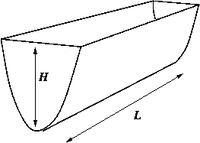
As you can see in this picture, a trough has a parabolic cross section
The problem is to calculate the force due to hydrostatic pressure on one flat parabolic side.
And here's the calculation I've come up with for this problem.
But this does not seem to be the answer, although I find it reasonable. Could anyone please shed some light on the problem, please?


